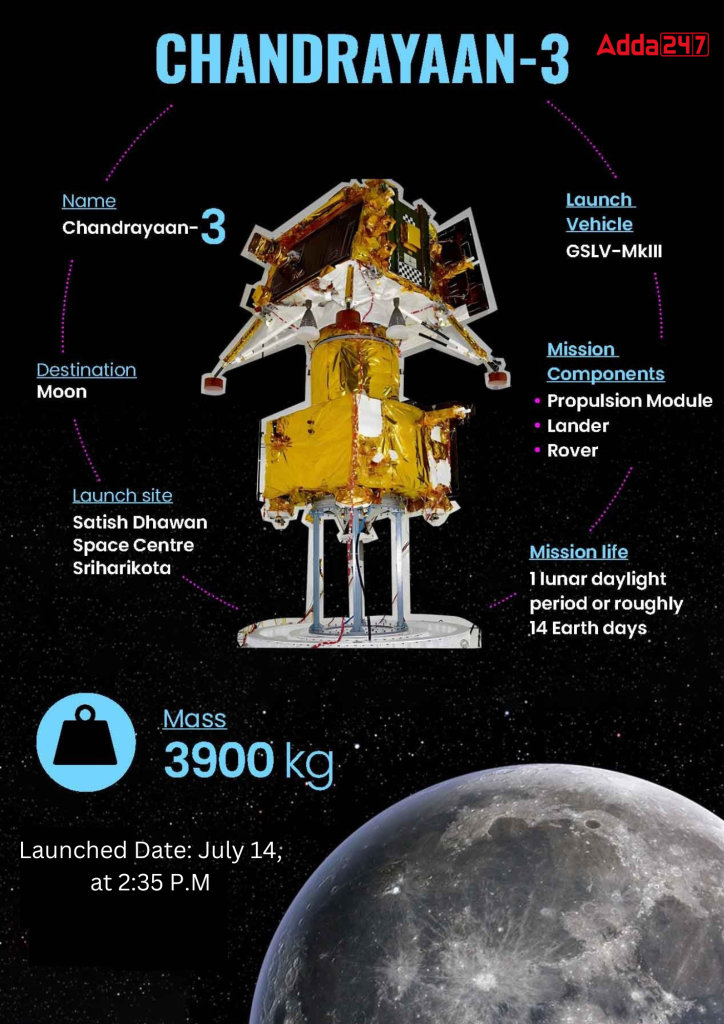Chandrayaan-3 Launch Date and Time
India’s lunar mission Chandrayaan 3 was launched on July 14, at 2:35 P.M. from Satish Dhawan Space Centre in Sriharikota announced by the Indian Space Research Organisation (ISRO).The date was later confirmed by Secretary of Space department and ISRO Chairman S. Somnath at a press briefing on the sidelines of the G-20 Fourth Economy Leaders Meeting in Bengluru.
Chandrayaan-3 Launch Countdown Live Updates
- India’s lunar spacecraft is set to achieve a remarkable feat by landing at the moon’s South Pole, a location where the presence of water molecules was discovered during India’s inaugural moon mission in 2008. This groundbreaking revelation had captivated the global audience at the time.
- India is striving to become the fourth country to accomplish a gentle touchdown on the Moon, following the United States, the Soviet Union, China, and Israel. Out of these nations, all except Israel were able to successfully achieve a soft landing on the lunar surface. If Chandrayaan-3 accomplishes a successful soft landing on the Moon, India will join this exclusive group as the fourth nation to reach this significant milestone.
- On Tuesday, ISRO (Indian Space Research Organisation) announced via a tweet that the ‘Launch Rehearsal’ for Chandrayaan 3 had been successfully completed. The rehearsal involved a comprehensive simulation of the entire launch preparation and process, spanning 24 hours.
- The rover of Chandrayaan is outfitted with two scientific instruments known as payloads: the Alpha Particle X-ray Spectrometer (APXS) and the Laser Induced Breakdown Spectroscope (LIBS). The APXS will play a crucial role in analyzing the composition of the lunar soil and rocks near the landing site, focusing on elements such as magnesium, aluminium, silicon, potassium, calcium, titanium, and iron. Its findings will provide valuable insights into the elemental makeup of the lunar surface.
About the Chandrayaan 3
The Chandrayaan-3 spacecraft will be launched by the Launch Vehicle Mark-III (LVM3). Chandrayaan-3 is a follow-up to Chandrayaan-2, to demonstrate end-to-end capability in safe landing and roving on the lunar surface.
- Chandrayaan-3 is a follow-on mission to Chandrayaan-2 to demonstrate end-to-end capability in safe landing and roving on the lunar surface.
- Chandrayaan-3 is consists of Lander and Rover configuration.
- Chandrayaan-3 will be launched by Launch Vehicle Mark-III (LVM-3) from Satish Dhawan Space Centre in Sriharikota.
- Chandrayaan-3 is consists of Lander Module (LM), Propulsion Module (PM) and a Rover with an objective of developing and demonstrating new technologies required for Interplanetary Missions.
- The Lander and the Rover have scientific payloads to carryout experiments on the lunar surface.
- The launcher identifies for Chandrayaan-3 is GSLV-MK3.
Chandrayan 3 Live Updates
Process of launching of Chandrayaan 3

Chandrayaan-3 is expected to soft land between August 23 and 24 at moon’s South Pole, the area which will have sunlight. The sunlight has to fall on the solar panels of the spacecraft. If these two dates were missed then the landing will be postponed to September around the time when there is sunlight on the moon. There is sunlight on the moon for 14-15 days.
Objectives of Chandrayaan-3
- To demonstrate safe and soft landing on the lunar surface.
- To demonstrate Rover roving on the moon.
- To conduct in-situ scientific experiments.
Technologies used in Chandrayaan-3
To achieve the objectives of the mission, several technologies are used in Lander and that are:
- Altimeters: Laser and RF based Altimeters.
- Velocimeters: Laser Doppler Velocimeter and Lander Horizontal Velocity Camera.
- Inertial Measurement: Laser Gyro based Inertial referencing and Accelerometer package.
- Propulsion System: 800N Throttleable Liquid Engines, 58N altitude thrusters and Throttleable Engine Control Electronics.
- Navigation, Guidance and Control: Powered descent trajectory design and associate software elements.
- Hazard Detection and Avoidance: Lander hazard detection & avoidance camera and processing algorithm.
- Landing Leg Mechanism.
Test carried out for soft landing of Chandrayaan 3
- Integrated Cold Test: For the demonstration of integrated sensors and navigation performing test using helicopter as test platform.
- Integrated Hot Test: For the demonstration of closed loop performance test with sensors, actuators and NGC using tower crane as test platform.
- Lander Leg Mechanism performance test on a lunar stimulant test bed simulating different touch down conditions.
Importance of the Chandrayaan 3 Mission
Missions like Chandrayaan hold great significance as they involve the participation of multiple countries. These collaborative endeavors contribute to scientific exchange and foster camaraderie among nations.
There is a potential for future international cooperation in exploring the south-polar region of the Moon. This region contains craters that are perpetually shadowed and devoid of sunlight. These cold, shadowed sites are believed to contain hydrogen, water, ice, and possibly even primordial material that can provide insights into the origins of our Solar System. Additionally, the largest lunar crater is located in the south polar region, and its formation around 4 billion years ago remains a mystery. Exploring and understanding our celestial neighbor will greatly contribute to our understanding of the cosmos.
The question may arise as to why India should invest in such high-tech endeavors instead of focusing on readily available technologies for the public good. The answer lies in the fact that these high-tech areas can indeed be used for the public good as well. Developing countries require knowledge in these areas to enhance the quality of life for their citizens. Space technologies have become indispensable for weather prediction, marine resource assessment, forest cover estimation, communication, defense, and various other domains. It is essential for every country to have a balance between futuristic technologies and those immediately relevant, allocating resources accordingly.
R. Chidambaram, a former Principal Scientific Advisor to the Government of India, once emphasized that active participation in emerging technologies positions a nation as a leader in that field, granting it leverage in international negotiations. This, in turn, enables a country to enhance its science and technology base, ultimately improving the lives of its citizens and elevating its prestige.




 States and Capitals - How Many States in...
States and Capitals - How Many States in...
 Where is the Headquarter of Asian-Pacifi...
Where is the Headquarter of Asian-Pacifi...
 Who is Known as Bengal Kesari? Know the ...
Who is Known as Bengal Kesari? Know the ...

